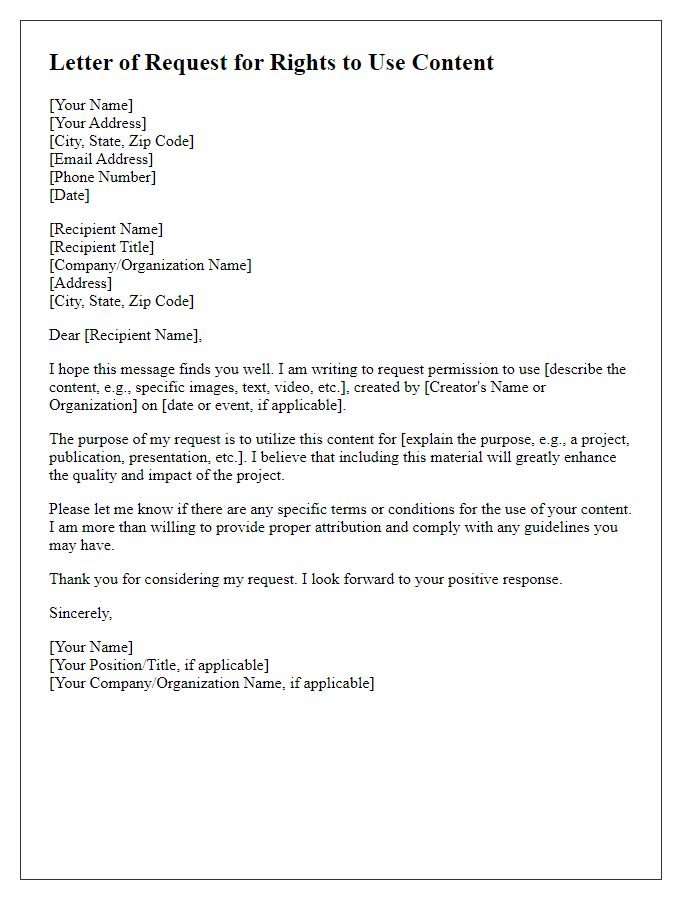Are you looking to obtain permission to use someone else's content, but unsure how to craft the perfect request? Writing a letter for this purpose doesn't have to be daunting; it can be as simple as clearly expressing your intentions and respect for the original creator's work. A well-structured letter not only conveys your request effectively but also sets a positive tone for any potential collaboration. Join us as we delve into a practical template that can help you get started on your journey to securing that all-important permission!

Clear identification of the content requested
In a formal request for permission to use specific content, it is crucial to clearly identify the exact material in question. For example, if the content is an article titled "The Impact of Climate Change on Coastal Cities," authored by Dr. Jane Smith and published in the Environmental Journal, specify the title, author, and publication date. Additionally, detail the type of use intended, whether it be for educational purposes, commercial redistribution, or inclusion in a publication. Providing context about the project or platform where the content will appear, such as an online educational course or a research paper, can strengthen the request.
Purpose and scope of use
Requests for permission to use content typically include specifics regarding the purpose and scope of use. Content such as articles, images, or videos may serve various functions, including educational purposes, commercial promotion, or research. For instance, a scholarly article in a peer-reviewed journal requires permission for inclusion in a thesis, emphasizing use for academic analysis. Commercial advertisements using visual content mandate clear intent, with possible reach metrics, like estimated views exceeding 100,000. Additionally, a non-profit organization might seek to utilize graphics for fundraising campaigns aimed at increasing awareness in specific communities. Clearly articulating these details establishes the context for permission assessment.
Duration and exclusivity of use
The authorization to utilize copyrighted content requires careful consideration of duration and exclusivity terms. Specific timeframes can determine how long the material is accessible for use, such as a fixed period of one year or ongoing until either party decides to terminate. Exclusivity clauses might grant a sole right to the requesting party, preventing others from utilizing the same content during the agreed timeframe, highly influencing marketing strategies and competitive advantage. Clarifying these parameters is crucial to avoid potential disputes and ensure both parties have a mutual understanding of rights and limitations involving the intellectual property.
Attribution and credit details
When using content from other creators, proper attribution is essential to maintain ethical standards and respect intellectual property rights. Clear attribution details typically include the creator's name, the title of the work, the source or publication, and a direct link when available. For instance, if utilizing a photograph by John Smith titled "Majestic Mountain," document the attribution as follows: "Photo by John Smith, 'Majestic Mountain,' used with permission from [Source Name/Website]." Additionally, specify the medium of content, such as a blog post, video, or artwork, ensuring comprehensive and precise credit to honor the creator's efforts. Always check for any specific requirements laid out by the original creator concerning usage rights and attribution format before proceeding.
Contact information for further communication
In the realm of content creation, seeking permission to use copyrighted material is critical for ethical standards. The request typically includes essential contact information for further communication, ensuring clarity and ease in correspondence. Key details, such as the requester's name, email address, phone number, and possibly their organization's name, should be explicitly stated. Including specific information about the content in question, such as the title, creator, and publication date, reinforces transparency. This structured approach not only facilitates effective communication but also demonstrates respect for intellectual property rights, which is vital in the creative industry.













Comments